Home » Archives for March 2013
Download
Popular Posts
-
John Atkinson and Stephen Mejias were unable to attend the Munich High End Show this year, so the call went out to the editors of Ste...
-
Time to settle into deeper listening. We'll spend a bit of time in Loggie Audio's second room, built around Ypsilon and (TEAC) ...
-
The floorstanding Canalis loudspeakers in the Spiral Groove room, driven by Qualia digital source and amplification, were new to me, bu...
-
Hey, we were in earthquake country, the land from which Carole King may have received inspiration to write, "I Feel the Earth Move...
-
I've been enjoying Julia Holter's Loud City Song . Mark your calendars: The album, Holter's third, will be released by Do...
-
Although most audio perfectionists look down with scorn on equalizers, there are times when the benefits of such devices can outweigh t...
-
It ain’t easy being 59 and living with the fact that what are arguably your best records are now 30 years old. Okay, King of American...
-
A reader once noted that I tend to stick with the same reference gear longer than most reviewers. In addition to Audience's Au24e i...
-
Silicon Valley–based Velodyne was founded in 1983 to develop a range of subwoofers that used servo-control to reduce non-linear distorti...
-
The audiophile does not pursue music reproduction because it is useful; he pursues it because he delights in it, and he delights in it ...
Market information
Blog Archive
-
▼
2013
(510)
-
▼
March
(71)
- Schiit BiFrost USB and Modi DACs Sweepstakes
- Gibson To Buy Majority Stake in TEAC
- Pass Laboratories XP-30 line preamplifier
- Ypsilon Aelius monoblock power amplifier
- Payday Albums: 3/29/13
- Luxman does DSD
- A Nice, Normal Dude Wins the V-Moda M-80 Headphones
- There's No Business Without Show Business
- Passion of the Hi-Fi: Part II - Dimensions
- News Flash: Oppo now plays DSD files
- When Saints Go Machine: "Love and Respect"
- Sarah Vaughan: "Tenderly"
- Too Many Shows?
- People Watching at the Coup de Foudre Party
- The new TT Two
- Bisson, free
- From the Gutwire
- Sonus Faber's Aïda
- The $5000 System
- Live at Leedh
- Lars at large
- Night Sky Courtesy of Blue Circle Audio
- Great Value from Cambridge Audio
- Gift from a flower to a garden
- DeVore doesn’t bore
- Plug and play
- And they’re off!
- Bel Canto Design C7R D/A receiver
- Velodyne Digital Drive Plus 18 subwoofer
- Snake Ears!
- The Entry Level #27
- Orson Wins a Benchmark!
- Music in the Round #59
- rlabarre Submits His Thoughts on the Audience aR2p...
- Montreal‘s Salon Son & Image Starts Friday
- Payday Albums: 3/15/13
- Blue Smoke's Black Box II
- Multichannel Mytek DSD
- An Effective Dem from Shunyata
- High Water Sound at Axpona
- Icon from the UK
- Audio Note UK
- Money Can Buy You...YG Carmels!
- Modwright: Dynamic And Smooth
- The Real Thing
- Music Hall's Marimba & Ikura
- Audioengine Rocks AXPONA
- The Benchmark DAC2 HGC
- Pure Vinyl & Music from Channel D
- Double DSD from M•A
- Crazy for BAT and Friends
- New Site in Websville
- Quintessence–Sonus Faber–REL–Audio Research
- Fresh Vinyl—Get Your Vinyl Here!
- Ediots . . . I mean Editors and Then Some
- You Never Know Just Who...
- Fosgate and Musical Surroundings' Happy Pairing
- CEntrance: Making Computer Audio Better
- Prepared for Chicago
- Mancave Metal Speakers at Axpona
- Spendor S3/5R2 loudspeaker
- Listening #123
- Video: "3AM" by Kate Nash
- Sexy Shlohmo
- The 2013 Pitchfork Music Fest Announces Initial Li...
- The Shape of Jazz to Come in 45rpm
- Three Days in England with KEF
- AXPONA Chicago Starts Friday
- Anne Bisson at Toronto’s Angie's Corner
- Logitech|UE 900 Noise-Isolating Earphones
- Payday Albums: 2/1/13 & 3/1/13
-
▼
March
(71)
Schiit BiFrost USB and Modi DACs Sweepstakes
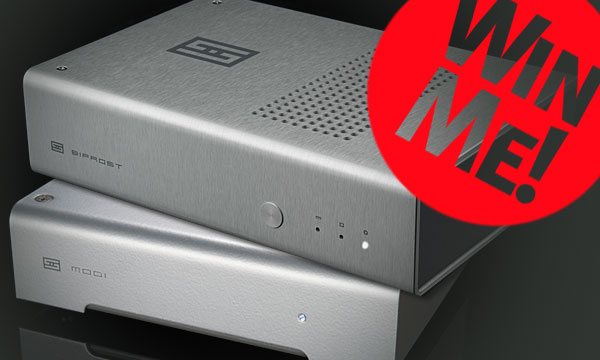
According to the company:
Bifrost:
Bifrost is the world's most affordable fully upgradable DAC, featuring 32-bit D/A conversion, a fully discrete analog section, and a sophisticated bit-perfect clock management system, together with one of the most advanced asynchronous USB 2.0 input sections available, as well as SPDIF coaxial and optical inputs, all with 24/192 capability.Fully Upgradable: The Future-Proof DAC Worried about rapidly-changing USB input technology? Concerned about future advances in D/A conversion? Bifrost's modular design uses separate, USB Input and DAC/Analog cards. The result? A virtually future-proof DAC that won't end up in the dumpster.
Even without considering upgradability, Bifrost offers incredible value. Consider its AKM4399 32 bit D/A converter, used in DACs costing many times more than Bifrost. Also consider that our analog section is a fully discrete, low noise JFET design—just like multi-thousand-dollar "statement" DACs.
Advanced Bitperfect Clock Management and a Complete Range of Inputs: Most DACs in this price range sacrifice every single one of your original music samples to get their magic "192kHz" spec. Every input is routed through a sample rate converter and upsampled to 24/192. Bifrost dispenses with the sample rate converter and uses a sophisticated master clock management system to deliver bit-perfect data to the DAC, preserving all the original samples--whether it's 16/44.1 or 24/192.
Have high-res music? No problem. Bifrost offers a full range of inputs: Coaxial and optical SPDIF, as well as USB. Bifrost's USB featues: a high-speed USB 2.0 interface and asynchronous data transfer to 24/192, based on the C-Media CM6631 USB receiver. No drivers are required for Macs, and Windows drivers are downloadable for Windows 8, 7, Vista, and XP.
Modi:
Modi is the most advanced USB DAC under $100 that is made in the USA. With a C-Media CM6631 USB 2.0 asynchronous input receiver and 24-bit AKM4396 DAC coupled to an active filter output stage, Modi is ideal for a computer-centered audio system.USB Powered, No Drivers : Modi plugs into virtually any Windows or Mac computer, and requires no drivers to deliver great sound, up to 24/96 sampling rates. It features asynchronous transfer with individual crystal oscillators for the 44.1 and 48k sampling rates, and uses the USB Audio 1.0 standard over USB 2.0, and is powered by the USB port. 24-Bit AKM4396 DAC .
Modi uses the 24-bit AKM4396 DAC with switched-capacitor filtering and a high-quality active filter section with excellent line-driving capability. Yeah, we know, engineerese is a disease. What this means is that it uses one of the highest-performance DAC ICs out there, and it will comfortably drive long cables. You can easily hide Modi behind your computer and run long RCAs to your main audio system.

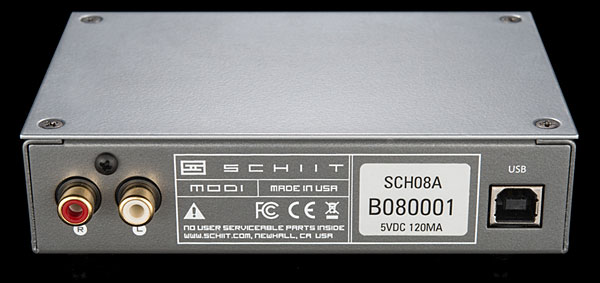
To enter the sweepstakes, all you need is an account on this website. If you don't already have one, click on the link labeled "register" at the bottom of this announcement or "Create new account" in the right column (under the ads). Then, enter a username and a valid e-mail address, and click on the "Create new account" button. A message will be automatically sent to the e-mail address you specified, which will include a link to activate the account.
The final step (and only step for those who already have an account) is to log in and leave a comment right here on this announcement—any comment will do, as long as it's not profane or spam. Then, when the sweepstakes closes, a lucky commenter will be chosen at random to receive the prize. So post a comment, and good luck!
For complete sweepstakes rules, click here.
Source : stereophile[dot]com
Gibson To Buy Majority Stake in TEAC

This is equivalent to a total price of around $52,482,000. The press release continued: "This is yet another step in Gibson’s aim to become the largest music and sound business in the world with the ability to deliver an uncompromising entertainment experience to the customer, spanning musical instruments to the most innovative recording and audio/visual devices. Adding TEAC products to Gibson’s line-up allows the company to offer tailored products to cater to every taste and economic range for music lovers, and music creators, around the world."
TEAC, Tascam, and Esoteric will become part of Gibson’s Pro Audio division, which includes the Cerwin-Vega, KRK, and Stanton brands, as well as Gibson's strategic partner, Onkyo.
Source : stereophile[dot]com
Pass Laboratories XP-30 line preamplifier
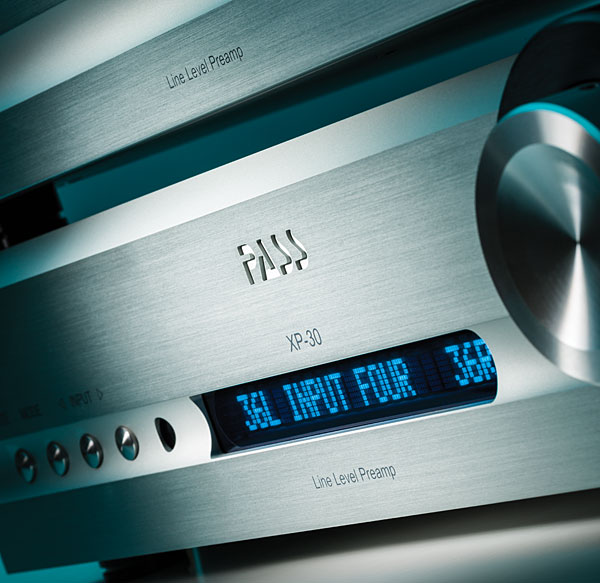
So much for the effect of expectations on perception: the KX-R sounded better than no preamp at all! As Wes Phillips described in his review, music sounded especially alive through the KX-R, whereas with the Transporter driving the amplifiers directly, it was all a touch less involving; acoustic objects within the soundstage were all a tad less fleshed out.
But it could be argued that my finding should not have surprised me. Ever since reviewing Audio Research's groundbreaking SP-10 preamplifier in July 1984, I have suspected that the preamplifier is the heart of a system, that it colors and adds its own character to every signal that passes through it. What I hadn't anticipated was that this character might not be a mere absence of negatives, but could also be a positive attribute.
At $18,500, the Ayre KX-R was way too expensive for my budget, but since then I have reviewed more affordable preamplifiers: the Simaudio Moon Evolution P-8 ($16,000, September 2009), the Ayre K-5xeMP ($3500, June 2011), and, most recently, the Classé CP-800 ($5000, September 2012), which includes an excellent D/A section. The Simaudio P-8 came closest to the KX-R's ability to maximize musical communication, but at a cost that also came close, while the Ayre K-5xeMP undoubtedly offered the best balance of sound quality and price. But my quest continues. So when Pass Laboratories' affable PR man, Bryan Stanton, told me about the California company's XP-30 preamplifier ($16,500), I asked for a review sample.
Enter the XP-30
The XP-30 is unusual in that not only are the electrically "dirty" control circuitry and power supply housed in a separate chassis—a concept I first saw in the Mark Levinson No.32, from the turn of the century—it uses a separate chassis for each channel's audio circuitry. And although the sample sent me for review was a conventional two-channel model, the XP-30 can, with additional chassis, be expanded to as many as six channels. Each audio chassis has both a Master and a Slave output, duplicated on balanced XLRs and single-ended RCA jacks. The Master and Slave outputs each has its own output driver, and the balance between their levels can be adjusted with a rotary control on the front of the audio chassis. This allows the Slave output to be adjusted for use with a power amplifier having a different sensitivity from that used with the Master output—when, for example, a pair of speakers is to be biamped with heterogeneous amplifiers.

Each audio chassis has six analog inputs, duplicated on balanced XLRs and unbalanced RCAs. (When the latter are used, pin 3 of the corresponding XLR needs to be shorted to the pin 1 ground; gold-plated jumpers are provided.) Input 6 can be used either as a conventional input or as a Pass-Thru, unity-gain input for a Home-Theater Bypass. There are also a Tape Loop input and output, again duplicated on XLRs and RCAs. A Mono jack is used to connect the left and right chassis with a short cable fitted with same-sex XLRs, so that a proprietary blend of the two channels can be used rather the true L+R mono when Mono is selected with the front-panel button. The remote control has no Mono button, and its Power button works only with Pass Labs' integrated amplifiers. The preamps are designed to be on all the time—there is no off button.
The control chassis is the same size as the audio chassis, and contains a pair of low-noise Plitron transformers in a dual-mono topology, EMI filtering, and a large amount of reservoir capacitance. It is dominated by a blue fluorescent display on its front panel and a large volume knob to the display's right. Other than the Mono button, a recessed row of pushbuttons to the display's left is duplicated on the chunky metal remote control. A pair of DIN-25 multi-pin connectors on the rear of the control unit supplies power to each of the audio chassis. The umbilical cables supplied are long enough (6') to allow the audio chassis to be placed where convenient. The manual warns that these umbilicals need to be connected before the preamplifier is powered up. However, if you don't do so, as I did one time during my testing, no harm will come to the XP-30. The power supply has to see the gain channel through a loop-back-and-delay circuit before it will send power to the audio chassis.
Outside the XP-30
According to the manual, the XP-30 "is the result of several years' effort by Wayne Colburn and staff at Pass Labs and has undergone numerous designs, redesigns, revisions, more revisions, adjustments and tweaks; more than any preamp product with the possible exception of the XP-25 phono stage."
Wayne Colburn? Although many assume that Pass Labs founder Nelson Pass is the sole creator of everything that emerges from the Sacramento factory gates, a team of four is responsible. Pass Labs president Desmond Harrington, once a digital engineer, does all the industrial design. Joe Sammut is responsible for marketing and sales but also takes the leading role in auditioning prototypes and deciding when they are ready for the world outside. And as well as Nelson Pass, Wayne Colburn is responsible for creative engineering.
Colburn had worked with Pass at Threshold—he had answered an ad in Audio Amateur magazine for a "wizard's assistant"—and rejoined him at Pass Labs in 1994. I asked Colburn how he and Pass divide their responsibilities: "Nelson prefers to work on power amps, including laying out his own boards. I do preamps—the circuitry, the board layout, I write the software." Colburn was typically modest about his contribution to Pass Labs' engineering, but admitted that he was responsible for its integrated amplifiers. Desmond Harrington, recruited from Krell in 1996 to work on the mechanical engineering for the then-new X-series amplifiers as a "temple for Nelson's designs," told me that Pass is fond of saying, "The shark must go forward": the business must always advance, the designs must always improve, and to do that takes a team with diverse but complementary skills. It appears that Pass has no problem "gathering the talent," as Harrington put it, to enable Pass Labs to go where he wants it to go.
Inside the XP-30
Each of the XP-30's audio chassis contains a single large, double-sided printed circuit board, with local three-pin voltage regulators and supply capacitance in abundance. Two large and two smaller caps, made by Clarity Caps and marked "Pass Labs," are presumably used for signal coupling. Input selection and switching are performed with high-quality relays, and a large, socketed CMOS chip handles the control housekeeping.

The input signal is fed first to the master balanced volume control, then to a symmetrical gain stage offering 10dB of voltage gain. This module, carried on a small daughterboard, is a more advanced version of the gain modules that have featured in Pass products since the 1990s. Claimed to have lower distortion and wider bandwidth than its predecessors, it also features a "dramatically" higher input impedance. The active devices are matched pairs of now-discontinued Toshiba JFETs and MOSFETs; however, Pass Labs says it has purchased enough of these parts to support production of the new gain stage for the next 10 years.
The gain module feeds the Master balanced output, a balanced–unbalanced summing amplifier that in turn feeds the single-ended Master output, and a pair of preset level potentiometers for the Slave output. These are followed by a unity-gain buffer to feed the balanced Slave output, and another balanced–unbalanced summer to feed the single-ended Slave output.
Article Continues: Page 2 »
| | |||||||||||||
Source : stereophile[dot]com
Ypsilon Aelius monoblock power amplifier
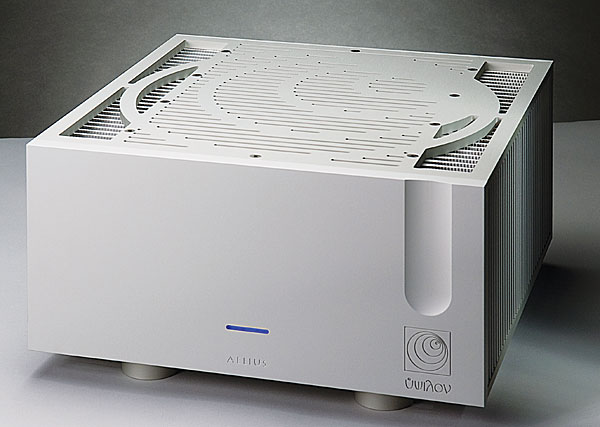
Greek austerity ends at the factory door of Ypsilon Electronics. The luxury components designed and manufactured within are innovative, high-performance, visually elegant, and expensive. They're aimed at audio enthusiasts, mostly outside Greece, who can afford to indulge themselves. Obviously, no Greek would object—the nation's economy, and those employed by Ypsilon, can only benefit from this small company's success, however minor the contribution.
Ypsilon's Aelius monoblocks cost $36,000/pair. That's a lot of money, but compared to some really expensive gear, including the Wilson Alexandria XLF speakers I reviewed in January ($200,000/pair) and Ypsilon's own SET 100 Ultimate amplifiers ($125,000/pair), the Aelius may be, for some, as Ypsilon's slogan suggests, "untouchable . . . but not unreachable."
Tube-rectified tube input, MOSFET output
The Aelius is moderately large and blocky; it measures 16.6" square by 9" tall and weighs 99 lbs. It's specified as outputting 200W into 8 ohms, 380W into 4 ohms, or 500W into 2 ohms, with the first 60W in pure class-A. Its tastefully understated satiny finish, sculpted front accent, and blue LED slit match the looks of the rest of the Ypsilon line.
Electrical engineer Demetris Backlavas has designed a circuit for the Aelius that has only two gain stages and almost no passive components in the signal path. The single-ended class-A tubed input stage uses a single C3g pentode tube (rectification for this stage is supplied by another tube) transformer-coupled to the push-pull output stage of six matched pairs of N-channel polarity MOSFETs. There are no source resistors in the circuit.
An interstage transformer is unusual in a solid-state or hybrid amplifier; one is used here as a "perfect" phase splitter for the Aelius's push-pull operation, and as a step-down transformer to greatly lower the input tube's impedance to drive the capacitance of the output MOSFETs. Though the phase is split and the amp is push-pull, it's really two single-ended amplifiers with six transistors driving the plus terminal and six driving the minus terminal—a very unusual circuit.
I visited Ypsilon while in Athens a few years ago. One afternoon, using an amplifier he was designing, Backlavas demonstrated the significant sonic differences produced by swapping out various capacitors, transformer core materials, and other components. The guy is steeped in theory but, ultimately, guided by his ears. Like a great chef, he knows how to obtain and mix the best ingredients to produce a sublime dish.
Backlavas points out that, without the transformer, an additional one or two active stages would have been needed to split the phase and lower the impedance and that those additional stages would reduce the amp's notable transparency and signal purity. Of course, transformers have their own problems, and building one with a sufficiently wide bandwidth (in this case, 10Hz–70kHz) is both difficult and necessary: the transformer's bandwidth defines the amplifier's bandwidth.
Backlavas says that while the Aelius's circuit is in some ways similar to the Circlotron configuration used in some output-transformerless (OTL) tube amps, it is not a true Circlotron. Unlike the Circlotron's unity-gain output, the Aelius's output is greater than unity gain. The result, Backlavas claims, is an amplifier with the sonic purity of a single-ended design, with push-pull power sufficient to drive virtually any loudspeaker.
Easy Connections
The Aelius's flat rear panel made all connections easy. Each of the "pure copper and gold-plated" speaker terminals has a large, round, screw-in knob of frosted plastic. These knobs are big enough to produce enough torque for a secure fit with even the stiffest cable when tightened by hand, and there's enough space between them to accept spades of any size, as well as banana plugs. Don't diminish the importance of this aspect of amplifier design—there's nothing more annoying than stupidly designed and/or placed terminals that seem to have been created by people who have never actually connected a speaker cable to an amplifier. Pay attention to this when you shop.
There are both single-ended RCA and balanced XLR inputs, chosen with an adjacent switch. Also on the rear panel is a handy ground lift switch for thwarting ground loops; this disconnects the ground circuit from the chassis ground. As with all Ypsilon products I've reviewed, the On/Off switch is on the rear.
As Supplied
Ypsilon specifies for the Aelius new old stock (NOS) of the military-grade Siemens C3g tube, which has eight pins, a metal sleeve, and a minimum lifespan of 10,000 hours. Unbeknownst to me, my review samples had been fitted with a Russian-made Electro-Harmonix 6C45PiEH tube, each with nine gold pins, that had been soldered into circular eight-pin adapter plates. (More below about why the swap was made.) I didn't discover this until after a month or so of listening, during which time I was also reviewing the Dan D'Agostino Momentum monoblocks (reviewed in February 2013), and using as references darTZeel's big NHB-458 monoblocks (August 2012).
With the 6C45PiEH tube, the Aelius produced a warm, voluptuous, somewhat darkly "tubey" sound that gave little hint of its solid-state MOSFET output (though MOSFETs are reputed to have a warmer, softer sound than bipolar devices). Yet despite the voluminous soundstage and generous bloom, instrumental attacks were precise and transients were cleanly delineated through much of the audioband, though the bass was less than taut, and not as nimble and as well controlled as I like it—and as I know the Wilson Alexandria XLFs are capable of producing.
Driving the very sensitive XLFs, the Aelius was probably running in class-A all the time, even when producing high (sometimes ridiculously high) SPLs in my moderately sized room. Considering the Aelius's class-A operation, zero feedback, and two-stage simplicity, it produced less transparency, and less of a direct, "straight-through" sound, than I'd expected. Nor, despite the use of tubes, did it produce the uncanny tonal neutrality I've come to expect from Ypsilon electronics.
My family visits during the holidays, and both of my sisters and my brother-in-law usually indulge me by spending 10 minutes or so listening to "what's going on down there" in my basement listening room. This time, the three of them sat there for well over an hour, and had to be prodded into going back upstairs. They sat through a side of Mel Tormé and Friends: Recorded Live at Marty's, New York City (2 LPs, Finesse W2X37484), and all of side 2 of the Beatles' Abbey Road. Unprecedented! What kept them sitting? The speakers, of course, but as driven by the Aeliuses, the width and depth of the Wilsons' soundstage was unusually enormous and enveloping—overwhelming, actually, and almost in our laps. Add a mesmerizing ease of sound that produced both reasonably good resolution of detail and billowy amounts of air and spaciousness, and it made for a very "wow" experience for all of us. The Mel Tormé record, in particular, was as "you are there" live as I've ever heard it.
Still, to my more experienced and critical ear the sound was overripe, somewhat diffuse, and tended toward softness, both at the very bottom and in the lower midrange, despite the latter's most attractive harmonic richness and the overall sound's uncanny textural verisimilitude.
The Aeliuses reproduced full-bodied, woody-sounding pianos from good recordings of solo pianos, but the attack cheated on the soft, diffuse, romantic side—too soft to correctly reproduce the attack of either startling and appropriately hard fortissimos or delicate yet well-focused pianissimos, not to mention all the dynamic gradations in between. Of course, the sound was always pleasing, but in the way that some audiophiles tend to romanticize how live music actually sounds.
It took me decades to acquire a system capable of cleanly and accurately delineating the honky-tonk piano of Nicky Hopkins (not Ian Stewart) in "Rocks Off," from the Rolling Stones' raucous Exile on Main Street (LP)—not to mention a system capable of separating out most of the parts from what most critics (with crappy systems) declared, in the early '70s, was "total sonic murk"—not that the proper playback of that particular album was my long-term goal!
Clearly hearing instruments and voices heretofore buried in the mix has always been among the more revelatory experiences of a worthwhile system upgrade, though it's not as wondrous as when a new component increases the listener's understanding of the music. The softness of that piano part clearly demonstrated the general softness of the Ypsilons' sound, particularly in the lower mids.
Switching to the admittedly more expensive D'Agostino Momentums ($55,000/pair), or to the hideously more expensive darTZeel NHB-458s ($150,000/pair), revealed—at least in my system—not only the Aelius's transient softness, but a dab of Vaseline on its sonic lens. This made everything sound "good," but robbed the greatness from recordings that truly were. Transparency, in particular, suffered.
Normally, I would have simply reviewed the amps as delivered, but given that these samples strayed from the preternaturally neutral, natural sound produced by every other Ypsilon product I've reviewed or heard at audio shows, I thought it best to contact the designer. Plus, last year, when a pair of preproduction Aeliuses were on the East Coast for some reason, Backlavas had asked if I'd like to hear them. I'd said I did, but that I wouldn't comment on what I heard or didn't hear.
The review samples did not sound at all like the preproduction pair. As I recall, Backlavas did tell me that for his first production run he was changing the material of the Aelius's transformer core, among other things, which would affect the sound, but the differences in sound between the two pairs of amps were so big that I called him.
After inquiring about the overall softness, and asking if that was what I was supposed to be hearing, I was told to expect another pair of input tubes. When the box arrived, I wasn't surprised to find in it a pair of C3g tubes, as specified in the instruction manual. But when I removed the amplifiers' ornately machined top plates, I was surprised to find, inside each, a 6C45PiEH instead of a C3g.
At the 2013 Consumer Electronics Show, I asked Backlavas what was going on. It turned out to be a combination of designer second-guessing and bureaucratic bullshit. Since 2006, the European Union's RoHS regulations (which mandate that solder be lead free but not CRTs—a much greater source of lead contamination, you can be sure) require documentation proving that no part of a new electronic component contains hazardous metals. This essentially outlawed the use of NOS vacuum tubes, of which the C3g is but one of many models, because no documentation exists that can prove their compliance with the regulations. While many high-performance audio manufacturers use NOS tubes anyway and ship to EU countries, Ypsilon was concerned about this and sought an alternative, currently manufactured tube. The 6C45PiEH proved a good choice that produced "interesting" results, Backlavas told me, adding that the tube "has midrange energy and body but it's darker and warmer."
Article Continues: Page 2 »
| | |||||||||||||
Source : stereophile[dot]com
Payday Albums: 3/29/13
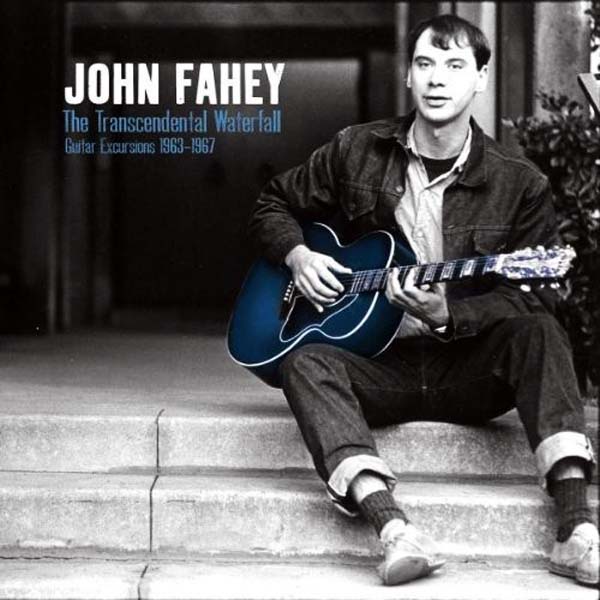
But it’s a 6-LP box set. The Transcendental Waterfall: Guitar Excursions, 1963–1967 collects John Fahey’s first six releases: Blind Joe Death, Death Chants, Breakdowns & Military Waltzes, The Dance of Death & Other Plantation Favorites, The Transfiguration of Blind Joe Death, The Great San Bernardino Birthday Party & Other Excursions, and Days Have Gone By.
The set was released by 4 Men With Beards, on December 18, 2012, and it nagged at me every day thereafter—I kept thinking, “Should I buy it? Should I buy it? Should I buy it?”—until I finally broke down and bought it. Really, I don’t know what took me so long. The set is limited to just 2000 copies, and I’m fairly sure that one of those copies was made just for me. Owning it, then, is not only a joy, but a relief: I can stop worrying about it. I can sit back, relax, listen, and wonder.
Now that I have one, I think that I should have bought two: one to play and one to stash away somewhere safe.
I don’t feel prepared to write about John Fahey. His music is extremely special to me, touches me in a way that no other music can. I’ve heard that Fahey was loving, reclusive, unpredictable, impetuous, his own worst enemy, a kind of mad genius—and I’ve read the books, have listened to the tapes, and have watched the videos, all of which do nothing to dispute those claims.
When I listen to John Fahey play the guitar, I think he must have been an angel.
In an interview with Byron Coley, for the Perfect Sound Forever webzine, Fahey said:
I’ve always really thought of myself as a spiritual detective and a psychological detective. I guess with my music I’m always trying to get to a fuller understanding of myself. I felt so alienated from the culture around me, like I was from a different planet, like I wasn’t really a member of the human race. I had two heads, one just wasn’t visible. So I was looking for another path of music. I didn’t really know what it was. I didn’t care what it was and I still don’t. Makes no difference to me and that’s perfectly okay. ’Cause I’m just a little blip. The whole style is just a little blip on all the mainstream of music. We don’t fit anywhere. And we never will.
The six 180gm LPs are housed in beautiful tip-on jackets, with perfect reproductions of the original album art and liner notes. In addition, The Transcendental Waterfall box includes a t-shirt, poster, and postcard. I bought my set, number 441, from Forced Exposure.
Source : stereophile[dot]com
Luxman does DSD

Saturday, May 4, 11am–4pm: The Gramophone (7913 104 Street NW, Edmonton, AB, Canada) will host an open house featuring Vivid Audio’s G3 Giya loudspeakers and a prototype Luxman DA-06 DSD DAC. On A Higher Note’s Philip O’Hanlon will be on hand to play a selection of his own vinyl records—on a Luxman PD-171 turntable, as well as in hi-rez PCM and DSD formats. Space is limited. RSVP: jinfo@gramophone.ca, (780) 428-2356.
Source : stereophile[dot]com
A Nice, Normal Dude Wins the V-Moda M-80 Headphones
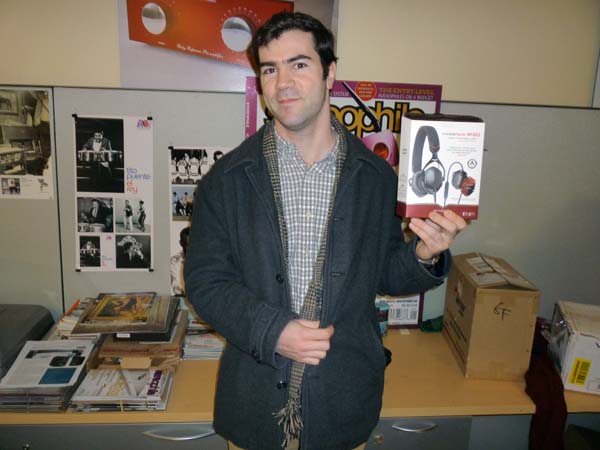
Zach “The Attacker” Packer is the happy winner of our recent V-Moda M-80 on-ear headphone sweepstakes. Packer, a New York City denizen, strode into the Stereophile offices at 261 Madison on a misty Manhattan afternoon confused by our corporate décor and cubicles. He commented, “You guys sure don’t have a lot of audio gear here.” All he could see were a few boxes of Quarkie’s animal-shaped in-ears. Sorry for the letdown Zach, but we keep our super-secret million-dollar listening room hidden from the public eye. Actually, I don’t even know where it is.
We’re always happy to see young and down-to-earth Stereophile readers like Packer. He mentioned all of his prior entry-level headphone gear, and it made Stephen and I feel all warm and fuzzy inside. Congrats on your winnings Zach. Keep on listening.
Source : stereophile[dot]com
There's No Business Without Show Business

This issue of Stereophile hits newsstands days after the first consumer Show of the 2013 season, AXPONA in Chicago, has ended. The next four months see audio shows in Montreal, New York, Munich, Newport Beach, San Francisco, and Washington DC. A goodly number of exhibitors at these shows could learn a thing or two from Ethel Merman, who took center stage in my consciousness after a discussion I had with John Atkinson at October's RMAF about blogging from shows. I was lamenting that I'd seen far too many exhibits that fell flat. The sound stank, or the room looked lousy, or the person in charge didn't have his or her act together, or all of the above. Why, I wondered, would a company spend countless hours and thousands of dollars on an exhibit space, only to blow the opportunity to strut their stuff before an audience of eager audiophiles? Don't they realize why they're there in the first place?
"It's a show," said John. "That's what some of them forget. They're there to put on a show."
Thankfully, many exhibitors don't forget. They work night and day for months on end to get their gear and presentation show-worthy. They arrive early for setup, and spend hour after hour tweaking the sound by trying different speaker positions, moving furniture, swapping cables, covering reflective surfaces, and applying room treatments. They do everything in their power to create a space that makes attendees want to listen, and then listen some more.
Certain names immediately come to mind. Constellation, dCS, Dynaudio, Joseph Audio, KEF, Magico, MBL, Nordost, Parasound, Peachtree, Scaena, Soundsmith, Synergistic Research, TAD, VTL, Wilson Audio, and YG Acoustics invariably excel in presenting their products, as do such distributors and dealers as Aaudio, Avatar Acoustics, Musical Surroundings, Music Lovers Audio, On a Higher Note, and The Voice That Is. Their attractive displays often include spotlighting, potted plants, and large banners that serve double duty as commercial signage and room treatments. Business cards and literature are easily accessible, as are lists of equipment on display, complete with prices. Browse the show reports at stereophile.com and, again and again, you'll see photos of the same companies' rooms, which stood out for their excellence of presentation.
But such exhibitors excel at far more than attractive rooms and handy literature. Their setups invariably include speakers whose dimensions, bass extension, and radiation patterns are appropriate for the space. If they demonstrate a huge, expensive speaker in a small room, it's only because they know that that model can sound good in close quarters. And if the room is large, they're sure to have enough amplification to fill the space.
Especially important, they know how to create an inclusive atmosphere. Many keep an eye on who's entering the room, and intersperse musical selections with succinct introductions to the equipment on display. They make space for people with lots of questions, as well as for those who mainly want to listen without interruption. It's a balancing act, and they do it well.
At the other end of the spectrum are bare, drab rooms that look like bachelor pads gone awry. Instead of potted plants or flowers, CDs and LPs are scattered this way and that. Questions about what's playing are often met with "I dunno. Joe—he's not here—burned it from a sampler that Usher Audio gave away years ago. All I know is that tracks 4, 7, and 8 are the best for the demo."
In other rooms, when you ask for model numbers and prices, you get blank stares, calls to the office, futile searches through Web pages and poorly organized binders. Some exhibitors neglect to demo well-broken-in samples of their products. "It needs 500 hours before it really sounds right," they say, trying to explain away the horrid sound they've just subjected you to. Sometimes they offer reasons for the lack of break-in, all of which seem plausible. Yet the fact remains: They're not playing show-worthy gear. Only so many people will buy equipment based on hype alone.
In some rooms you wait in vain for the music because the exhibitor is deep in conversation—he's shouting, or playing music so softly it seems an afterthought, or both. That you're eager to listen to music makes no difference; whatever topic has seized his attention takes precedence. You stick it out, hoping you'll eventually hear what you came for . . . or you move on.
Most dismaying are the exhibitors who, asked to play something that will show off their systems' strengths, serve up blank stares. Alternately, they offer a stereotypical list of audiophile favorites—the same RCA Living Stereo and Reference Recordings blockbusters, the same albums by Diana Krall and Anna Netrebko, the same tracks from Ella and Louis and Brubeck's Time Out, the same classic rock you hear day after day at show after show.
You ask for something classical and they put on a movie soundtrack. You offer a USB drive full of unusual, wonderfully recorded tracks, and they don't know how to load them into their server. They're anything but John DeVore (of DeVore Fidelity) or Garth Leerer (of Musical Surroundings), or Peter McGrath (of Wilson Audio), each of whom always has something new and exciting he's eager to share.
Bravo to the exhibitors who get it, who remember. Time and again, they manage to fill acoustically challenging hotel rooms with beautiful, engaging, viscerally exciting music. They know what it takes to put on a good show, and they rise to that challenge. Is it any wonder that their equipment wins the most attention and the most reviews?
As for the rest, La Merman could have sat them on her knee and told them a thing or two about show biz, without which there's no business at all!
Source : stereophile[dot]com
Passion of the Hi-Fi: Part II - Dimensions
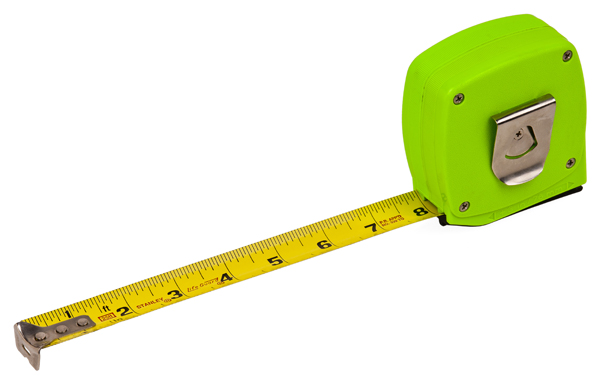
I charged up to Jared’s chamber: “Dude. Today is the day we measure the rooms. We need to know the truth.” Not only did I need to know the room dimensions to find the best room for my system, but as roommates, we needed to reassess the rent prices to set for each room.
With our handy-dandy measuring tape, we unveiled the following room dimensions (LxWxH, rounded to the nearest quarter of a fraction):
- Bedroom One: 20¼' x 12½' x 10½'
- Bedroom Two: 12' x 12' x 7'
- Bedroom Three (my current listening room): 12¼' x 11½' x 8¼'
- Bedroom Four: 7½' x 8¼' x 8½'
- Living Room: 16¼' x 11½' x 8½'
These dimensions were a revelation.
First of all, I had been overpaying for my room for the past three years under the impression it was the largest room in the house. Politely conned by previous roommates, Bedroom One’s sloped walls disguised the actual floor-space available making it appear smaller. These sloped walls also meant room acoustics could be unpredictable. Despite the added floor-space for storage of hi-fi boxes, unpredictable room acoustics were not a risk I was willing to take.
Limited size and physical obstructions hindering my current room made moving into the living room a realer option, but the costs for the additional space would be a consideration.
When I showed JA my room measurements, he noticed the near square shape of my current room and commented, “That will likely lead to some unwanted bass resonances and an overall unevenness in the bass response.” This is exactly what I had been experiencing. Woah. Random mid-bass frequencies were unnecessarily activated through my Usher S-520s. These same units were used in the Stereophile review where JA states, “the S-520s low-frequency alignment has been tuned for clarity and articulation rather than boom.” This is not what I heard.
I then showed JA the measurements of my living room, to which he responded, “Oh wow. That will make you a happy man.” Happiness. Could you imagine that?
Maybe my room has been the problem all along. There is only way to know. The most expensive upgrade I may make is a rent hike. But it’s worth it, right?
Source : stereophile[dot]com
News Flash: Oppo now plays DSD files

Oppo has just offered "Public Beta Test Release" firmware that provides a plethora of new features and fixes, most of which are addressed to audio matters. The players will now support AIFF files, exFat drives, and have enhanced support for CUE files and playlists. Most important, since it is at the top of the change list, is "support for Direct Stream Digital (DSD) file playback from local storage. The DSD files can be either stereo or multi-channel. Both the DFF and the DSF formats are supported."
A review of these Oppo players will appear soon in the May "Music in the Round" and I will be following up with a report on my experiences with multichannel DSD playback. However, I have been using this new feature for a month now and it is too important to hold back.

One simply plugs a USB drive (formatted FAT32 or, now, exFat) with DSF or DFF files into the front or back USB "A" jack on the Oppo and select it as source. The DSD files will appear on the track/album/artist lists on the video display (above). Just click and play as with the more familiar WAV, FLAC, etc. files.
Now, here's the really good news. The Oppo will play multichannel as well as stereo DSD and that makes the Oppo the least expensive multichannel DSD-file player by a wide, wide margin. I have been enjoying glorious multichannel downloads from Channel Classics' website as well as a couple of their spectacular "live" session files (Mahler Symphony 1 and #) made at the recording and without edits. Wow is all I can say.
Here are the caveats. Oppo warns that it "is not possible to revert back to any previous official or beta firmware releases once this version is installed on the player. There will be no problem upgrading to any future official or beta firmware releases." They add that "due to the extensive changes in this major firmware update, it is required that the user performs a "Reset Factory Defaults" operation after the firmware is installed . . . You may experience stability issues if this step is not performed." Also, streaming DSD files from a server is not yet possible.
But this is a big deal. So, at the moment, it is your move but an official release is undoubtedly just on the horizon.
Source : stereophile[dot]com
When Saints Go Machine: "Love and Respect"

When Saints Go Machine have just announced their sophomore album, Infinity Pool. Surprisingly, the album’s first single, “Love and Respect,” features Killer Mike offering a strong and exciting contrast to Nikolaj Manuel Vonsild’s delicate falsetto, while a heavy hip-hop beat, distorted bass line, and pitch-shifting synths push and pull throughout.
Here, as with Konkylie, I was initially unimpressed, wanting more from both Killer Mike and Vonsild. But after a second listen, and then a third, I’ve remembered that wanting more isn’t necessarily a bad thing.
When it comes to When Saints Go Machine, I’ve grown used to not trusting my first impressions. Infinity Pool will be released by !K7 Records, on May 28th.
Source : stereophile[dot]com
Sarah Vaughan: "Tenderly"
Sarah Lois Vaughan was born on this day in 1924, in my hometown: Newark, NJ. In this clip, taken from a 1958 performance, she sings “Tenderly.”
Thanks must go to Lester Perkins and Jazz on the Tube.
Source : stereophile[dot]com
Too Many Shows?
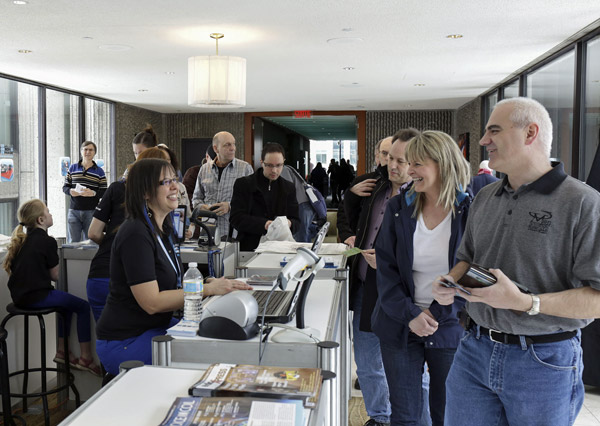
The number of exhibitors at the 2013 SSI was down significantly from last year (from 85 to 70, according to the report by Jason Serinus. There is a Toronto show, which has had two successful years, and their next show is being held November 1–3, 2013. The Toronto show provides additional competition for the Montreal show, at least for exhibitors. The Montreal show gets some attendees from Toronto, but my sense is that this is not a major effect. Most of the people attending the Montreal show are from the Montreal area.
In any case, although I have no figures on this, attendance at the Montreal show seems to be holding. Friday was a bit on the quiet side, but the corridors on Saturday were teeming with people, and many rooms were difficult to get into. Show organizers Michel Plante and Sarah Tremblay keep coming up with new ideas to make the show interesting, eg, this year's headphone exhibit, and the designated "Under $5000" systems. And, as a group, exhibitors are at least as intent to share their love of music as they are to "move product." As a result, and with the cheerful, highly competent contribution of the SSI staff—like Claudia L'Ecuyer at the registration desk, shown in the picture—attending SSI is simply fun. Look at the faces of the people in the picture and see if you don't agree.
Source : stereophile[dot]com
People Watching at the Coup de Foudre Party
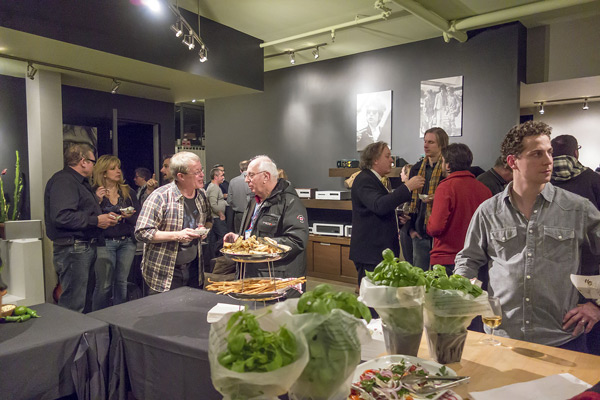

The charming Jennifer Cytrynbaum.

Graeme Humfrey in his mixing studio.

Recipients of the 2013 Lifetime Achievement Awards, Brian Russell and Angie Lisi .
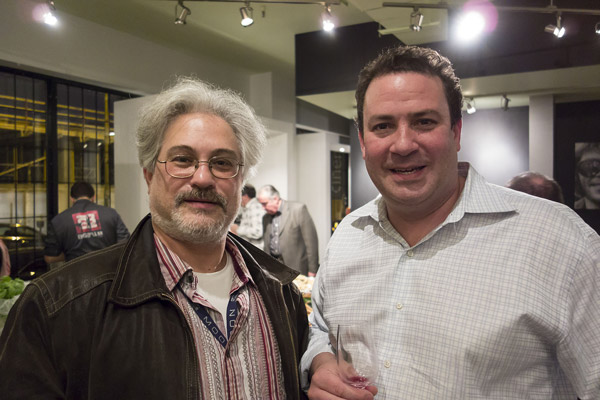
Lionel Goodfield of Simaudio (left) and Stereophile Publisher Keith Pray (right).
Source : stereophile[dot]com
The new TT Two
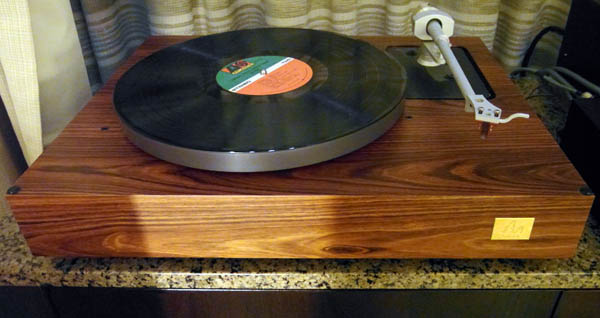
Source : stereophile[dot]com
Bisson, free
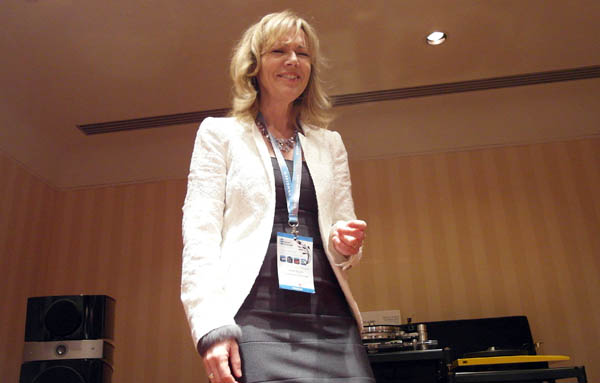
On Saturday morning at SSI, I stepped into the Oracle Audio room just in time for owner Jacques Reindeau to invite me to hear a few selections from the album Blue Mind by the Montreal-based composer and chanteuse Anne Bisson, played on an almost all-Oracle system—with the artist standing in front of me, singing along with her recorded self. Thus did the lovely Ms. Bisson take the floor, sometimes singing along in unison, sometimes in harmony, sometimes in counterpoint, and, at one moment, accompanying the sung line with a soft sprechgesang. I was enchanted. And, yes, with but one exception, I was spoiled for the rest of the day, and I grumbled inwardly every time I heard notes that were less real and less lovely.
Source : stereophile[dot]com
From the Gutwire
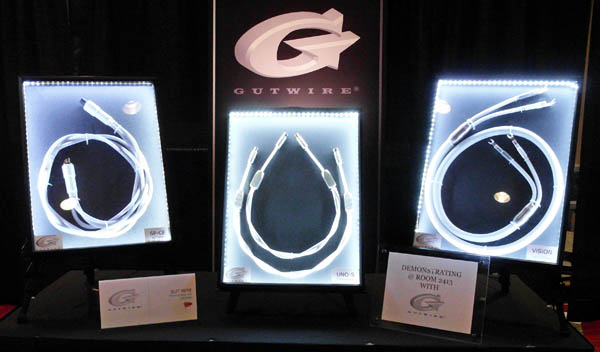
Source : stereophile[dot]com
Sonus Faber's Aïda
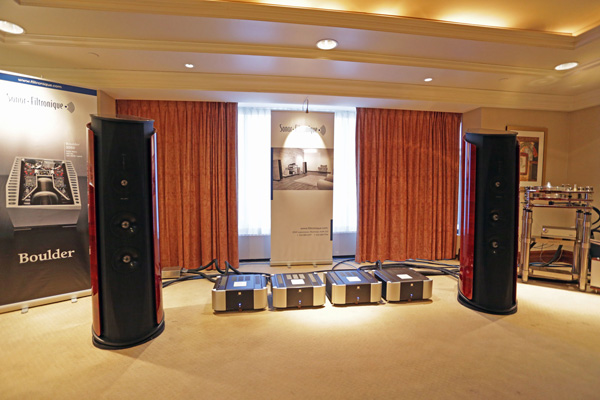
And then I got it. The speaker was named after Aïda, pronounced "eye-ee-duh," the well-know opera by Verdi. I guess the rep was not an opera fan.
With that out of the way, I was able to enjoy the Aïdas ($130,000/pair), driven by four Simaudio 880M monoblocks ($21,000 each). Paradoxically, they did not sound like giant speakers—which I think of as a positive trait, and difficult to accomplish, especially when the speaker has multiple drivers, front and back, like the Aïda.
Source : stereophile[dot]com
The $5000 System
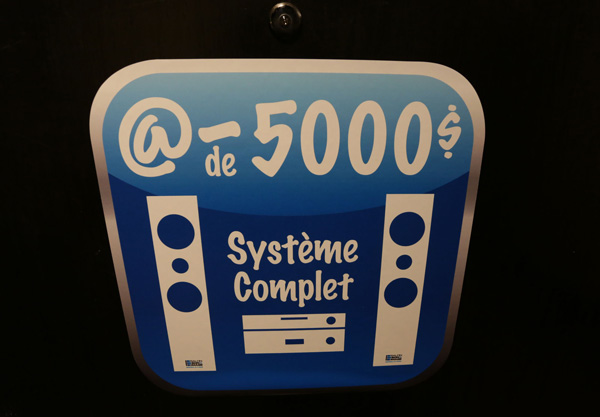
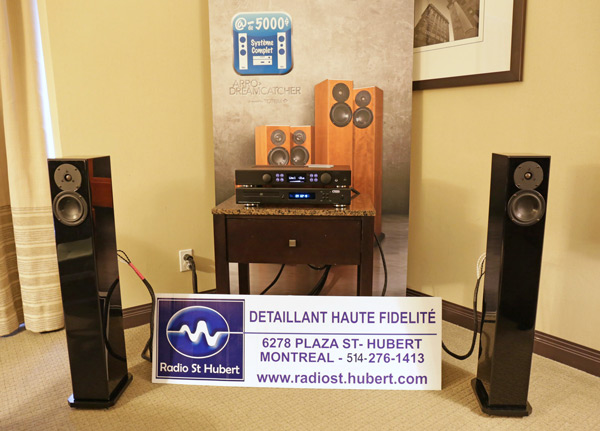
Source : stereophile[dot]com
Live at Leedh

Incidentally, when I returned home from Montreal, I gave the Leedh fact sheet to my 15-year-old daughter, who is studying French. She said that the designers claim to have started with “a clean slate,” in reaction to flaws in “traditional loudspeakers,” and that iron pole pieces and standard cone suspensions have, in particular, been avoided.
Source : stereophile[dot]com
Lars at large
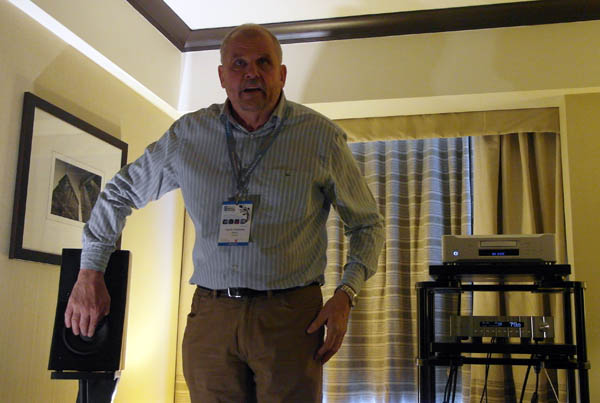
Source : stereophile[dot]com
Night Sky Courtesy of Blue Circle Audio
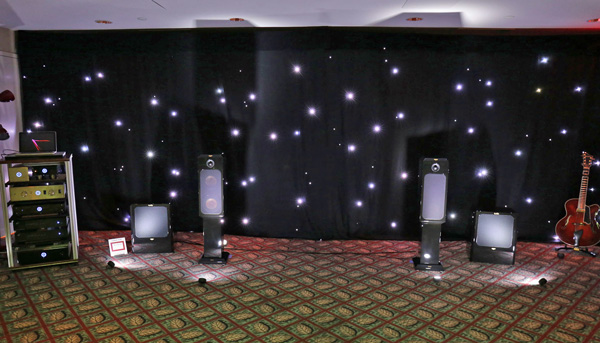
Source : stereophile[dot]com
Great Value from Cambridge Audio
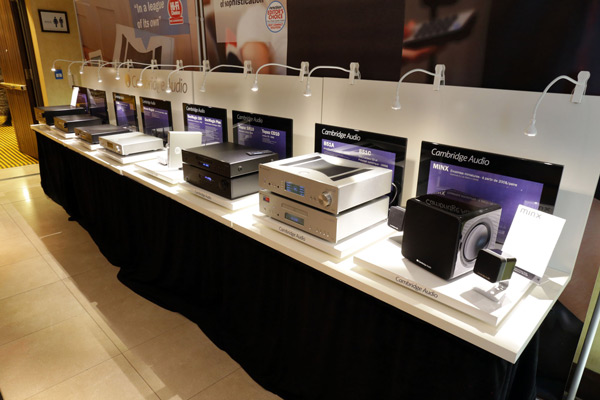

Source : stereophile[dot]com
Gift from a flower to a garden
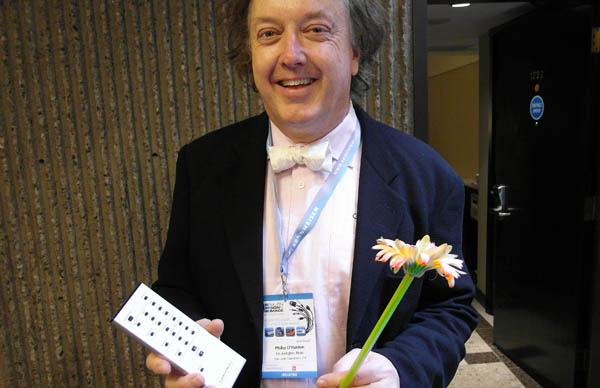
Source : stereophile[dot]com


